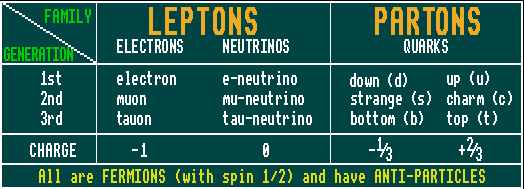

The electrons (electron, muon and tauon; e, ![]() , and
, and ![]() ) have unit negative charge, and come in three generations, each heavier than the preceding.
) have unit negative charge, and come in three generations, each heavier than the preceding.
The neutrinos have zero electrical charge and little or zero rest mass, less than 10eV. The electron neutrino is associated with the electron, the ![]() -neutrino with the muon, and the
-neutrino with the muon, and the ![]() -neutrino with the tauon, each in a higher energy regime. Each neutrino may or may not have an anti-particle; they may be their own anti-particles. See Neutrino.
The rest mass of the electron and of the positron is about 511KeV. The muon has a rest mass about 200 times that of the electron, or 105.6Mev, and a lifetime of 2.2 microseconds, decaying into an electron, a muon neutrino and an electron anti-neutrino. The two neutrinos cannot mutually annihilate each other because they belong to different generations. The tauon (
-neutrino with the tauon, each in a higher energy regime. Each neutrino may or may not have an anti-particle; they may be their own anti-particles. See Neutrino.
The rest mass of the electron and of the positron is about 511KeV. The muon has a rest mass about 200 times that of the electron, or 105.6Mev, and a lifetime of 2.2 microseconds, decaying into an electron, a muon neutrino and an electron anti-neutrino. The two neutrinos cannot mutually annihilate each other because they belong to different generations. The tauon (![]() ) is heavier still at 1.87GeV, decaying in 0.3 picosec.
) is heavier still at 1.87GeV, decaying in 0.3 picosec.
The partons, which make up baryons and mesons, consist of three generations of quarks of increasing energy, two in each generation. The quarks have units of charge based on exactly a third of the charge of the electron, and cannot be isolated, but group in either twos (forming mesons with integral spin) or threes (forming baryons like the proton with half integral spin). The quarks are much heavier than the electron and possess a property called colour-charge which prevents their isolation. Not shown are eight bi-coloured gluons which bind the quarks in pairs or in threesomes.
All these fermions are point-like and have oppositely charged anti-particles.
It has been conclusively proved that there are only three such generations. Only the members of the 1st generation are stable against decay, the others seeming to be exited (higher energy) states of the first generation.
The masses of the quarks depends somewhat on their surroundings. The up quark is the lightest at 60MeV - 311MeV, followed by the down quark at 100MeV - 315MeV. The strange quark weighs 200Mev - 500MeV whilst the charmed quark 1500MeV - 1650MeV. The bottom quark 5100MeV and the massive top quark somewhere between 91GeV - 200GeV.
Two fermions (½-integral spin particles) can pair up (with opposite spins) to become a composite particle with integer-spin, in other words, a boson. This happens in superconductivity, where two electrons pair-up, and in mesons, where a quark and anti-quark pair-up. [In superconductors, however, it is theoretically possible for electrons to pair up, not with opposite spin, but with the same spin - but only in 2004 has one superconductor been found that does this].
Fermions obey Fermi-Dirac Statistics whereby no two can occupy the same quantum numbers, being Pauli's exclusion principle.
![]()
![]()